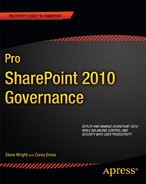Governance OF the Users
In this book, we will explore the concept of governance as it applies to a business's use of the SharePoint family of products. We assume the reader is familiar to some degree with the concepts of web sites, collaboration, and portals as they apply to SharePoint. SharePoint provides a platform for creating, storing, and retrieving information. This information is generically referred to as content and it can take many forms such as documents, calendars, lists, and web sites. The features of SharePoint allow users within an organization to collectively or individually create content and publish it for others to use. By making this information quick and easy to find, categorize, and organize, SharePoint can provide a lot of business value. SharePoint is also a very extensive product that contains many features that can cause problems if not used correctly.
Establishing a SharePoint Server 2010 environment is reasonably simple, but maintaining it and controlling it in a way that maximizes its benefits to the users and the business is not. SharePoint consists of many interrelated subsystems and services such as Search, Content Management, Record Management, PerformancePoint Services, and so on. SharePoint also serves as a platform for integrating and delivering other Microsoft products such as Dynamics, Project Server, and SQL Server Reporting Services. Additionally, there are numerous third-party vendors that provide SharePoint-based products to provide solutions for backup and recovery, data archiving, image management, and many other things. With all of these potential features available, it is reasonable to assume that not all of them will be appropriate for your environment.
One of the most important decisions to be made when delivering a SharePoint-based solution is to determine which of the supported features should be made available to the end users and which should not. The most common mistake made by organizations when they adopt SharePoint is to install the product and tell their users to “go ahead and use it.” This approach can cause many problems, but the two most common are the following:
- No one uses the system because they don't really know what it can do for them.
- Users begin dumping huge amounts of data into SharePoint with no organization or categorization.
By governing the features available to users, the goal is not to prevent the use of certain features, but to encourage the use of those features that are of most value to the organization.
